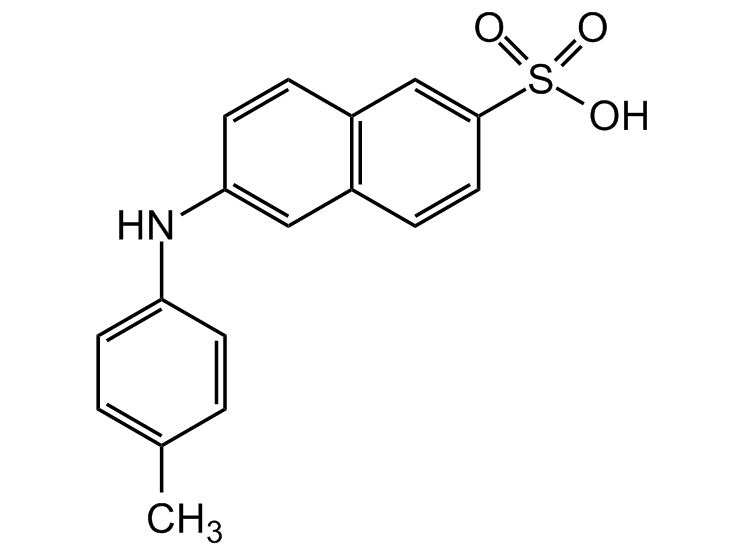6-(p-Toluidino)-2-naphthalenesulfonic acid
| Code | Size | Price |
|---|
| CDX-T0008-M250 | 250 mg | £121.00 |
Quantity:
Prices exclude any Taxes / VAT
Overview
Regulatory Status: RUO
Shipping:
AMBIENT
Storage:
Short Term Storage: +20?C. Long Term Storage: +4?C
Images
Documents
Further Information
Alternate Names/Synonyms:
2,6-TNS
Appearance:
White to off white powder.
CAS:
7724-15-4
EClass:
32160000
Form (Short):
solid
GHS Symbol:
GHS07
Handling Advice:
Protect from light and moisture.
Hazards:
H315
InChi:
InChI=1S/C17H15NO3S/c1-12-2-6-15(7-3-12)18-16-8-4-14-11-17(22(19,20)21)9-5-13(14)10-16/h2-11,18H,1H3,(H,19,20,21)
InChiKey:
VTRBOZNMGVDGHY-UHFFFAOYSA-N
Long Description:
Chemical. CAS: 7724-15-4. Formula: C17H15NO3S. Molecular Weight: 313.37. 6-(p-Toluidino)-2-naphthalenesulfonic acid (TNS) is a widely recognized aminonaphthalene-based fluorescent probe characterized for its solvatochromic effect. TNS is found to be almost fluorescence silent in aqueous medium whereas shows a high quantum yield in organic solvents with a hypsochromic shift, as the polarity of the medium decreases. This property has been exploited in biological studies to probe the micellation properties of surfactants, membrane fluidity, hydrophobic surfaces on proteins, conformational changes upon ligand binding, ligand binding events, protein-surfactant interactions, multimeric protein assembly or aggregation, fibril formation and others. TNS has been used in many studies as environmentally sensitive fluorescent probe for the conformational state of proteins. TNS fluorescence enhancement upon binding to unfolded states of proteins might be due to the hydrophobic environment and reduced solvent accessibility rather than the binding ability and specific orientation of TNS in the bound state. Studies suggest that TNS forms aggregates in water whereas in non-aqueous solvents the order of aggregates is lower which might result in an enhancement of its fluorescence intensity. Further, TNS preferably interacts with basic and aromatic amino acid residues of the proteins. TNS is a well characterized fluorescent probe of protein structure that fluoresces in nonpolar environments but is quenched and red-shifted in solution. Spectral data: lambdaex 320nm; lambdaem ~440nm.
MDL:
MFCD00041942
Molecular Formula:
C17H15NO3S
Molecular Weight:
313.37
Package Type:
Vial
Product Description:
6-(p-Toluidino)-2-naphthalenesulfonic acid (TNS) is a widely recognized aminonaphthalene-based fluorescent probe characterized for its solvatochromic effect. TNS is found to be almost fluorescence silent in aqueous medium whereas shows a high quantum yield in organic solvents with a hypsochromic shift, as the polarity of the medium decreases. This property has been exploited in biological studies to probe the micellation properties of surfactants, membrane fluidity, hydrophobic surfaces on proteins, conformational changes upon ligand binding, ligand binding events, protein-surfactant interactions, multimeric protein assembly or aggregation, fibril formation and others. TNS has been used in many studies as environmentally sensitive fluorescent probe for the conformational state of proteins. TNS fluorescence enhancement upon binding to unfolded states of proteins might be due to the hydrophobic environment and reduced solvent accessibility rather than the binding ability and specific orientation of TNS in the bound state. Studies suggest that TNS forms aggregates in water whereas in non-aqueous solvents the order of aggregates is lower which might result in an enhancement of its fluorescence intensity. Further, TNS preferably interacts with basic and aromatic amino acid residues of the proteins. TNS is a well characterized fluorescent probe of protein structure that fluoresces in nonpolar environments but is quenched and red-shifted in solution. Spectral data: lambdaex 320nm; lambdaem ~440nm.
Purity:
99% (HPLC)
Signal Word:
Warning
SMILES:
OS(C1=CC(C=CC(NC2=CC=C(C)C=C2)=C3)=C3C=C1)(=O)=O
Solubility Chemicals:
Soluble in DMSO.
Transportation:
Non-hazardous
UNSPSC Category:
Fluorescent Reagents
UNSPSC Number:
41105331
Use & Stability:
Stable for at least 2 years after receipt when stored at +4°C.
References
(1) J.R. Lakowicz & D. Hogen; Biochemistry 20, 1366 (1981) | (2) G.V. Ohning & K.E. Neet; Biochemistry 22, 2986 (1983) | (3) J.R. Lakowicz & S. Keating-Nakamoto; Biochemistry 23, 3013 (1984) | (4) G. Maniara, et al.; Photochem. Photobiol. 47, 207 (1988) | (5) E. Bismuto, et al.; Biochemistry 28, 7542 (1989) | (6) Y. Dotskias, et al.; J. Pharma. Biomed. anal. 23, 997 (2000) | (7) N. Pattaramanon, et al.; Biochemistry 46, 3405 (2007) | (8) N. Haque & N.P. Prabhu; J. Mol. Struct. 1068, 261 (2014) | (9) N. Haque, et al.; Phys. Chem. Chem. Phys. 19, 24656 (2017)



